Chinese AWACS aircraft: the beginning of the journey
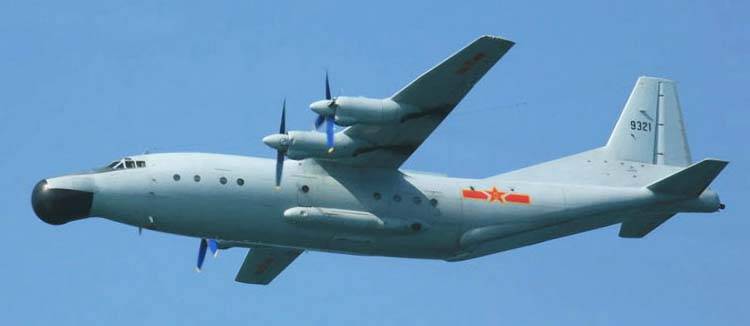
In the 1960s, the USSR and the USA were armed with Tu-126 long-range radar patrol aircraft (based on the Tu-114 turboprop airliner) and EU-121 Warning Star (based on the Lockheed L-1049 Super Constellation piston transport and passenger aircraft), capable of detecting air targets at a distance of several hundred kilometers. Although the first AWACS aircraft had many shortcomings, and their radar and communications equipment was not very reliable and vulnerable to interference, flying radar posts demonstrated their usefulness from the very beginning of operation. The most valuable quality was the ability to see air targets much earlier than ground or shipborne radars could. This made it possible to timely activate the forces and means of air defense, to direct the actions of the fighter aviation and aim interceptors at the most dangerous targets.
In the 1950s, real air battles took place over the Formosa Strait between the PLA Air Force and the Republic of China Air Force. The most dangerous air adversaries from Taiwan were American-made North American F-86 Saber jet fighters, which were opposed by MiG-15s and MiG-17s. Although Soviet fighters were not inferior to the Saber in their main characteristics, the level of pilot training was of great importance. An important trump card of the Taiwanese fighters was that they could carry AIM-9 Sidewinder guided missiles. Periodically flaring up fierce air battles went with varying success, and despite the consulting and technical support from the USSR, the pilots of the PLA Air Force often lost battles.
In the 1960s, the level of armed confrontation between the parties decreased somewhat, but violations of the air border of the PRC by reconnaissance aircraft taking off from airfields located in Taiwan were still a frequent occurrence.
Under the current conditions, the PLA Air Force had an urgent need for a flying radar picket capable of monitoring the airspace over the strait and the island of Taiwan. If necessary, AWACS aircraft could be transferred to a threatened direction, thus compensating for the lack of ground-based radar posts in remote areas.
Until the early 1960s, Chinese developers of weapons and military equipment could rely on support from the USSR, but after relations between the countries deteriorated, military-technical cooperation ceased, and China had to rely only on its own strength. Thus, by the time the Tu-126 AWACS aircraft with the Liana radio-technical complex was adopted by the Soviet Air Force, there was no question of sending it to China.
DRLO KJ-1 aircraft
Creating a truly effective and fairly reliable radar and communications system for an AWACS aircraft is still a very difficult task. However, in the mid-1960s, Chinese specialists took up the solution of this problem.
At that time, the only type of aircraft on the basis of which a “flying radar” could be created in the PRC was the Tu-4 long-range bomber. Back in 1953, when relations between the allies were cloudless, the Soviet Union handed over 25 Tu-4 bombers. In turn, the Tu-4 was a copy of the American Boeing B-29 Superfortress.
Due to moral and physical obsolescence, some of the Tu-4 bombers in China were modernized. One Tu-4 was used as a platform for placing a radio engineering complex, other modernized vehicles subsequently served as carriers of unmanned aerial vehicles.
In order to improve flight data during the modernization carried out in parallel with the overhaul, four ASh-73TK piston engines (2400 hp each) were replaced by AI-20K turboprops (4250 hp each). An increase in the total engine power by more than 1,5 times made it possible to compensate for a significant increase in aerodynamic drag and payload mass. The introduction of new engines became possible due to the fact that, just before the end of Soviet-Chinese cooperation, the PRC handed over a package of technical documentation for the An-12 military transport aircraft with modern theaters at that time. Simultaneously with the establishment of the An-12 construction, Chinese enterprises mastered the production of AI-20K engines, which received the designation WJ-6.
Compared to the piston ASh-73TK, the WJ-6 turboprops were longer, which changed the centering and affected the aircraft's controllability. To increase stability, it was necessary to increase the span of the horizontal stabilizer by 400 mm, while its area became 2 m² larger. Also, vertical washers were installed on the tips of the horizontal tail and under-keel ridges. On the Tu-4, the propellers of the piston engines had right-hand rotation, and on the AI-20K, the propellers rotated to the left. At the same time, a heeling moment arose, which had to be parried by altering the control and changing the balancing. Operators and equipment were placed in a completely redesigned bomb bay.
The radio engineering complex weighed 5 tons, the diameter of the disk-shaped rotating antenna was 7 meters. All electronic units were built on very energy-intensive electron tubes, which required the use of additional power generators. It took 19 months to convert the bomber into an AWACS aircraft.
The first Chinese AWACS aircraft, designated KJ-1 (KongJing-1 - "Kong Jing", usually translated from Chinese as "Heavenly Eye"), took off on June 10, 1971. During flight tests, he showed data that differed little from the base Tu-4.
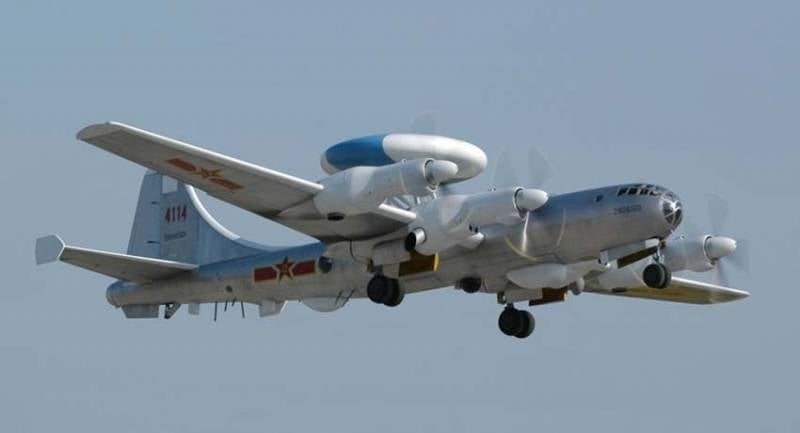
The first Chinese aircraft ARLO KJ-1
The maximum takeoff weight of the KJ-1 has increased by 3 tons. But thanks to more powerful engines, the maximum speed remained almost the same - 550 km / h. Patrol speed - 420 km / h. The aircraft could stay in the air for about 10 hours. Crew 12 people.
If the problems with controllability and stability were solved quickly enough, then the radio engineering complex was debugged for a long time and difficultly. In the course of turning on the equipment, failures constantly occurred. This was largely due to the fact that a significant part of the RTK element base was assembled from Soviet components or Chinese analogues that were in pilot production, which had unstable characteristics. Many problems were caused by the poor protection of the crew from high-frequency radiation. In fact, the pilots, and especially the RTK operators, when the radar was turned on, found themselves inside a giant microwave oven, which, of course, did not add health to people.
When designing the RTK of the KJ-1 AWACS aircraft, the need to simultaneously create equipment for automatic data transmission to interceptors and ground command posts was overlooked. Fighter guidance could only be carried out by radio, in voice mode. However, at that time, the Chinese armed forces did not have automated command and control systems, and there were no specialized interceptors in combat units. The adoption of the first Chinese air defense fighter-interceptor J-8 took place only in 1980.
A few years after the first flight of the KJ-1 aircraft, its radio-technical complex, at the cost of heroic efforts, nevertheless managed to be brought to a working state, and it even showed good results.
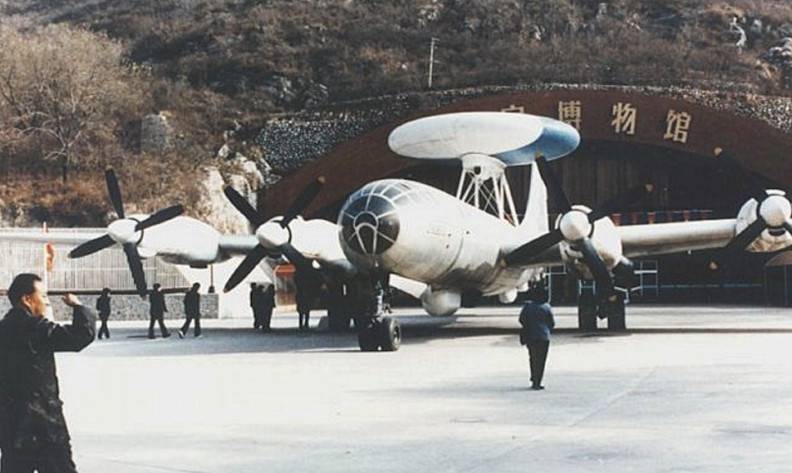
The RTK detected large high-altitude air targets at a range of 300-350 km, large surface targets - 300 km. However, it was not possible to achieve stable detection of aircraft against the background of the earth's surface. For the selection of air targets against the background of the earth, sufficiently productive computers were required, which, of course, could not be in China at that time.
Taking into account the exorbitant cost of a very “raw” RTK, the laboriousness of setting up and the complexity of operating equipment built on electric vacuum devices, the PLA Air Force command considered it irrational to serially build KJ-1 radar patrol aircraft. It is possible that a small number of Tu-4 aircraft suitable for conversion played a role.
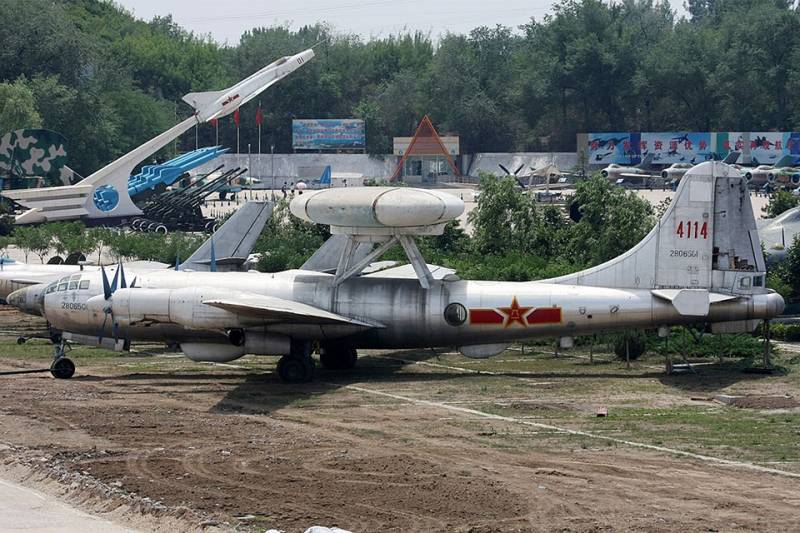
The first Chinese AWACS aircraft was maintained in working condition until the mid-1980s and periodically participated in various exercises and tests. Currently, the KJ-1 aircraft is on display at the China Aviation Museum, in the suburbs of Beijing.
The first Chinese AWACS aircraft based on the military transport Y-8
Although when creating the radio-technical complex of the KJ-1 aircraft, due to the weakness of the Chinese radio-electronic industry, “the first pancake came out lumpy,” the PLA command still wanted to get a flying radar picket suitable for searching and monitoring air and surface targets.
Such an opportunity presented itself in the 1980s, when anti-Sovietism brought about a rapprochement between the United States and China, after which China gained access to modern Western technologies and finished defense products.
In the first half of the 1980s, China acquired several American AN / APS-504 radars suitable for installation on patrol aircraft. This station, operating in the 8,9 - 9,4 GHz frequency range, was previously installed on American anti-submarine aircraft. The AN / APS-504 radar had a circular and sector view mode, the antenna rotation speed was 12 rpm. By scanning the space in the lower hemisphere, it was possible to detect large surface targets at a distance of up to 370 km.
Although the AN / APS-504 radars at the time of purchase were no longer the last word in radar, their use allowed the Chinese maritime patrol reconnaissance aircraft to rise to a new level of development, and American radars were installed on Y-8 aircraft (Chinese version of An-12).
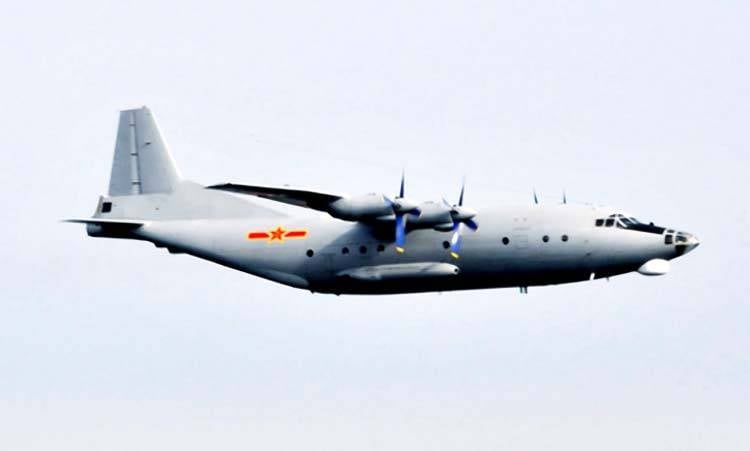
Y-8X
The patrol aircraft, equipped with the AN/APS-504 radar, received the designation Y-8X and began performing long-range reconnaissance flights in 1986. In addition to the radar, on board the Y-8X there were electronic intelligence and electronic warfare stations, cameras, infrared sensors, a magnetometer, a sonar buoy signal receiver, advanced Western-made communications and an Omega navigation system. The rear ramp was tightly sewn up, and the interior was divided into several compartments for operators and electronic equipment. According to reference data, a total of four Y-8X aircraft were built.
Due to the obsolescence of radars and the impossibility of obtaining spare parts for Western-made electronic equipment, about 15 years after the start of operation, the Y-8X aircraft were modernized, while the options for upgrading different machines differed significantly.
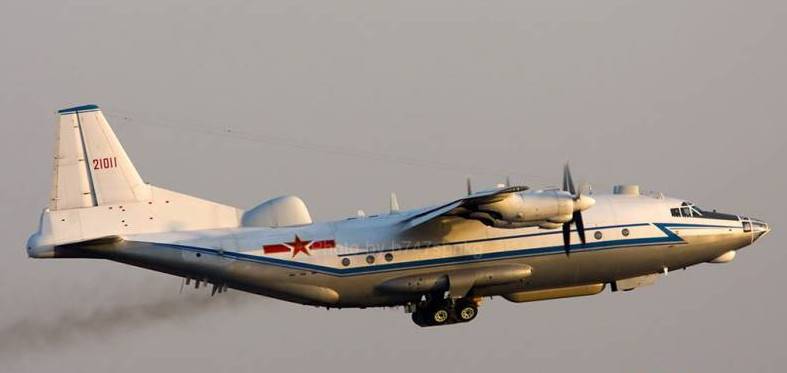
The most interesting modification was an aircraft with a side-looking radar and a satellite communications antenna located next to the tail unit. Two more machines were converted for conducting electronic and photographic reconnaissance, and one aircraft was equipped with a new radar for a circular view of the sea surface.
In the mid-1990s, bypassing sanctions, China purchased 66 (according to other sources - 6) Skymaster radars from the British company Racal Electronics for $ 8 million. The stations, which received the designation Type 515 in the PRC, operated in the frequency range of 1-2 GHz. Initially, it was planned to equip the SH-5 hydroplanes with such radars, but later the transport Y-8 was considered a more suitable platform.
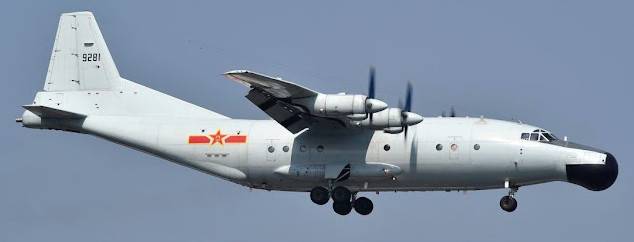
Y-8J
According to the official version, voiced in the Chinese media, the Y-8J radar patrol aircraft were intended "to fight smugglers" and "ocean research". They are easily recognizable by their characteristic "beard" of dark color.
Radar Type 515, installed in the bow, can control the sea area within a radius of 250 km. At a range of 80-90 km, the radar is capable of detecting submarine periscopes. Low-altitude air targets with an EPR of 5 m² are detected at a distance of 110 km. The radar can simultaneously observe 100 air and 32 surface targets. The aircraft was also equipped with aerial cameras, additional suspension units for bombs and buoys, as well as larger fuel tanks, which increased the patrol duration to 11 hours at a speed of 470 km / h. The maximum speed of the aircraft is 660 km/h. 3-4 people are employed in maintenance of the onboard equipment. The total crew size is 7-8 people.
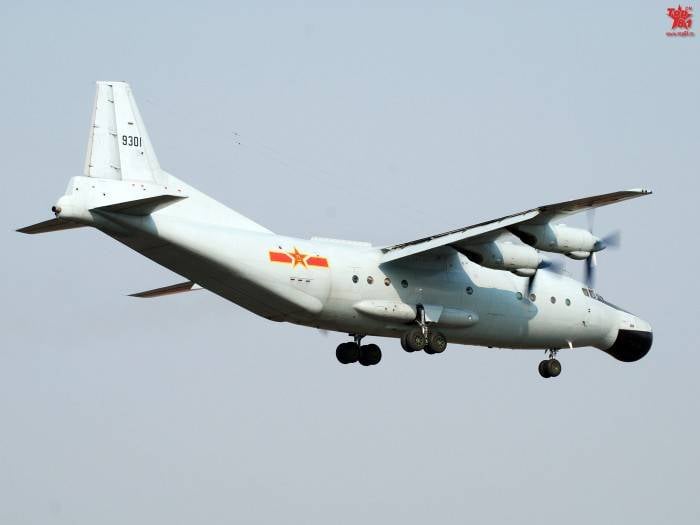
To supply power to equipment and equipment in the tail section of the aircraft, an additional turbogenerator was placed in place of the cockpit of the arrow of the rear defensive installation.
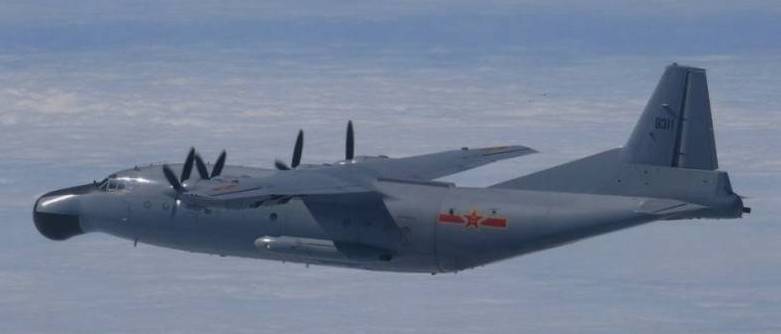
The commissioning of the Y-8J took place in 2000, after about 10 years the patrol aircraft underwent modernization. The means of displaying information have changed, instead of CRT monitors, color LCD displays have been installed. The onboard equipment included modern radio intelligence stations and new means of communication. After modernization, the aircraft received a dark ball color.
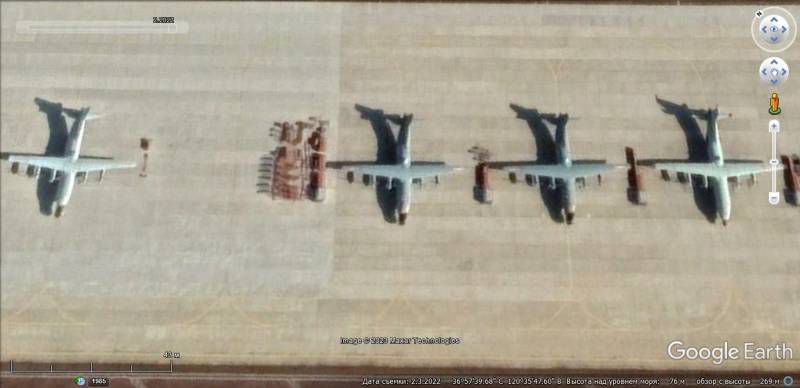
Satellite image of Google Earth: Y-8J and Y-8X aircraft at Layan airbase
Albeit with some restrictions, the Y-8J became the first Chinese AWACS aircraft capable of directing military aviation operations. On a permanent basis, Y-8X and Y-8J are based at Laiyang Air Base in Shandong Province and Danchang Naval Air Base in Shanghai.
Radar and electronic reconnaissance aircraft based on the Tu-154
In the 1980s and 1990s, China bought more than 40 Tu-154M medium-haul airliners. Most of them were operated by civilian airlines, and 12 aircraft were handed over to the military and used to transport the country's leadership and high-ranking military personnel. The military Tu-154M from the very beginning was based at the Nanyuan airbase in the vicinity of Beijing, which belongs to the 34th Air Force Division. Judging by the available satellite images, part of the Tu-154M is still used by the PLA Air Force.
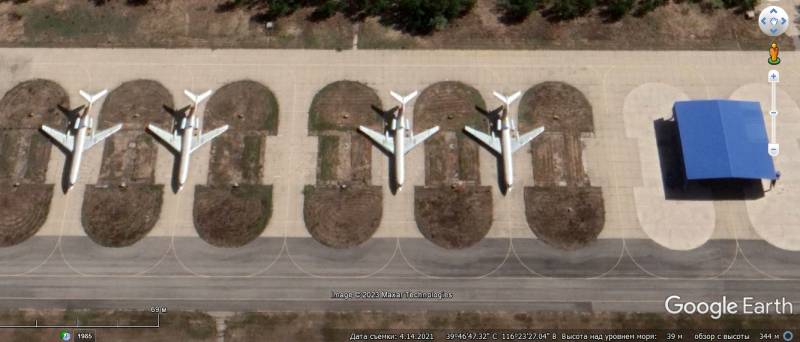
Satellite image of Google Earth: Tu-154M aircraft at the Nanyuan airbase
Due to poor-quality ground handling in the 1990s, two Tu-154M crashes occurred in the PRC, in which more than 220 people died. In 1999, all civilian airlines of the PRC abandoned the operation of Carcasses, and two dozen aircraft in good technical condition were sold to Russia and Kazakhstan.
The Chinese military also abandoned part of the Tu-154M, but they were not written off, but converted into radar and electronic intelligence aircraft. But, despite the military purpose, these vehicles carry civilian identification marks and numbers.
According to American data, 154 airliners were converted into the variant, which received the designation Tu-7MD.
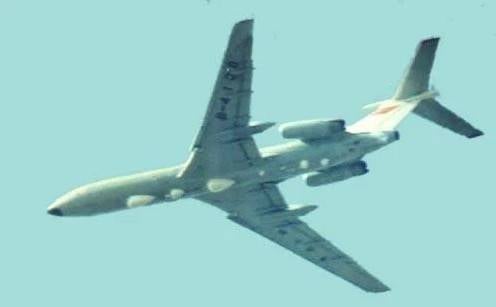
The first Tu-154MD, equipped with special equipment, took off in 1996 and had several different-sized antennas in the lower fuselage. This aircraft was supposed to perform the same functions as the Russian Il-20M or the American E-8 JSTARS.
According to information published in Chinese sources, this aircraft used a radar with a maximum range of 105 km, which was almost 2,5 times less than the capabilities of the American E-8A with the AN / APY-3 side-looking radar.
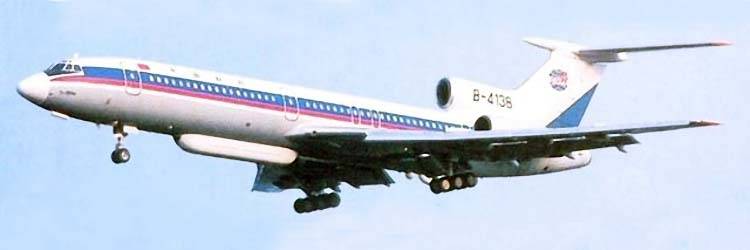
Subsequently, the Tu-154MD received the Type 863 radio complex with a long "canoe-shaped" synthetic aperture radar antenna.
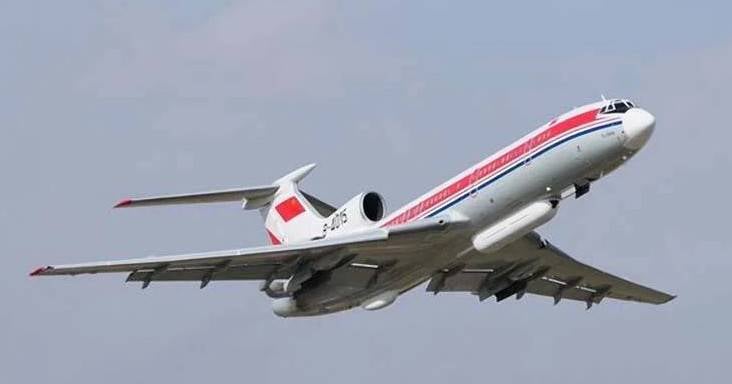
Closer to the tail there is another fairing with an antenna system for electronic intelligence. The aircraft also carries a wide array of high-definition television and infrared cameras. The transmission of information in real time is carried out through satellite communication channels or over a radio network using repeater aircraft.
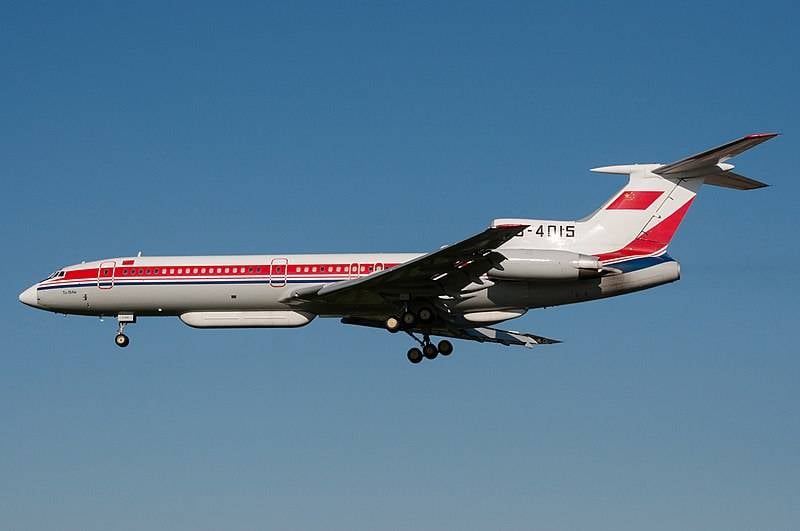
Tu-154MD reconnaissance aircraft flying along the borders of Japan, South Korea and tracking American warships in the Pacific Ocean regularly meet foreign fighters in the air. In the past, Chinese reconnaissance aircraft with civilian markings have repeatedly scanned Russian air defense systems in the Far East.
Radar reconnaissance aircraft based on the J-8II interceptor
The PLA Air Force command was aware that bulky and low-speed reconnaissance aircraft based on the passenger Tu-154M and military transport Y-8 are very vulnerable to enemy fighters and medium and long-range anti-aircraft missile systems. In this regard, in the late 1980s, the development of a tactical supersonic reconnaissance aircraft began in the PRC, capable of viewing enemy defenses to a depth of several tens of kilometers when flying along the line of contact using radar.
At that time, the only suitable combat aircraft available to the PLA Air Force was the J-8II supersonic interceptor, which, conceptually and outwardly, strongly resembled the Soviet Su-15.
In the mid-1990s, the J-8FR aircraft entered service with the Chinese tactical reconnaissance aircraft. While externally similar to the interceptor, the reconnaissance version is very different from it in the composition of onboard equipment and weapons.
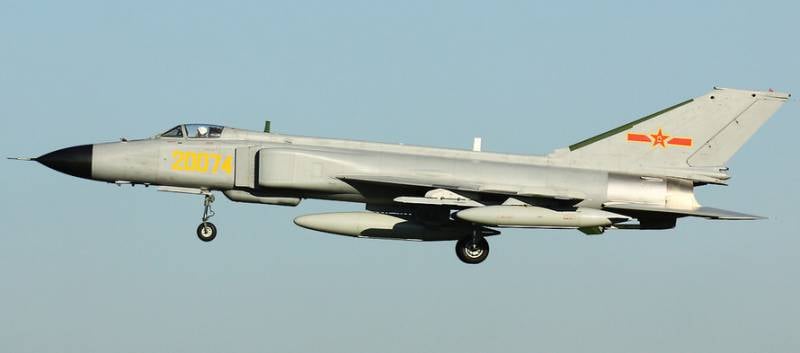
Tactical reconnaissance J-8FR
On this aircraft, the Type 1492 airborne target detection radar was replaced by a compartment with photo and television cameras. Instead of the dismantled 23-mm cannon, optoelectronic equipment with a wide field of view was installed on board, capable of operating in the dark. But the most notable innovation was the suspension of the side-looking radar container. This synthetic aperture radar is capable of conducting radar reconnaissance at a distance of more than 100 km. For self-defense against enemy fighters, two PL-9 melee missiles can be suspended.
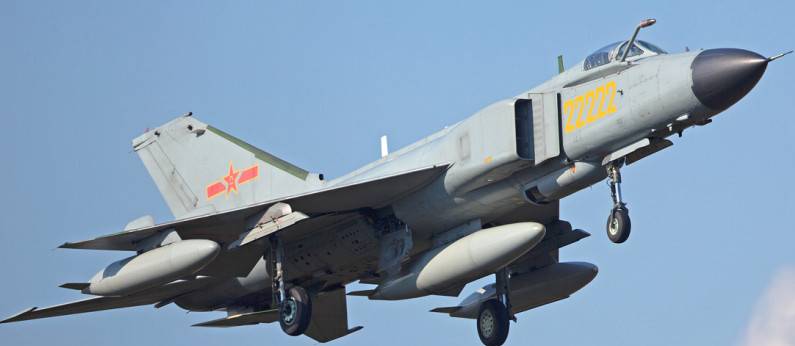
Although the interceptors of the J-8II family are largely obsolete, thanks to the consistent modernization of the avionics, good acceleration characteristics and high rate of climb, they still remain in service. In the afterburner, the thrust-to-weight ratio of the J-8F interceptor approaches one. The reconnaissance version also has good speed parameters. At high altitude, its speed can exceed 2M. With a supply of fuel in the internal tanks, the range of the J-8FR reconnaissance aircraft reaches 900 km. To increase the duration of the flight, the aircraft can carry 600 and 800-liter external fuel tanks, and there is also equipment for refueling in the air. Small-scale construction of J-8FR reconnaissance aircraft was carried out until 2012, and they serve in reconnaissance squadrons in the northeast and southwest of China. In the near future, they are supposed to be replaced by medium and heavy class UAVs.
To be continued ...
Information